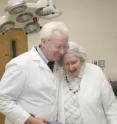What makes C-Diff superbug deadly?
A major breakthrough about the potentially deadly superbug Clostridium difficile (C-diff) could lead to new ways to combat the bacterium, according to a study to be published March 1 in the journal Nature. The study reveals that for decades researchers have been focusing on the wrong toxin that is released by the bacteria in the colon. The toxin can cause severe diarrhea and life-threatening colitis that could lead to the surgical removal of the colon.
"For 20 years, we have been focusing on Toxin A. But it turns out the real culprit is Toxin B," said study co-author Dr. Dale Gerding. "This is a major finding in how C-diff causes disease in humans. It completely flips our whole concept of what the important toxin is with this disease."
Gerding is a professor of medicine, division of infectious diseases, Loyola University Chicago Stritch School of Medicine, Maywood, Ill., and associate chief of staff for Research, Hines VA Hospital.
C-diff is a spore-forming bacterium that was discovered in 1978 to be the cause of antibiotic-associated diarrhea and colitis. It is rapidly spreading through health-care facilities around the globe. When the normal bacteria that live in the colon are disturbed, usually as a result of antibiotic treatment, and a patient ingests C-diff spores, the bacteria can multiply and release the two toxins.
C-diff sickens about 500,000 Americans a year, contributing to 15,000 to 20,000 deaths, The epidemic strain has been found in 38 states, including Illinois. It now rivals the superbug known as MRSA as one of the top emerging disease threats to humans. Since its discovery, C-diff has grown increasingly resistant to antibiotics. Though it is appearing more often in younger people, those 65 years and older face a greater risk of developing infection from C-diff and have more severe outcomes and higher death rates.
Symptoms of C-diff include profuse diarrhea and abdominal pain and distention of the abdomen. An infection is also frequently accompanied by fever, nausea and dehydration. In some rare cases blood may be present in the stool. The infection is spread by spores that contaminate the hospital environment and hands of healthcare workers who can transmit the spores to patients. The resistance of the spores to hospital cleaning agents and to alcohol hand disinfectants makes it extremely difficult to eradicate.
Gerding noted that a human clinical trial using a drug that bound Toxin A more than it bound Toxin B failed to treat C-diff effectively.
"There's probably a good reason why the trial failed," Gerding said. "We now know that Toxin B should have been the primary target." –
The study has major implications for the future development of treatments and preventative measures for C-diff, said Gerding and co-author Dr. Stuart Johnson, associate professor of medicine, division of infectious diseases, Loyola University Chicago Stritch School of Medicine.
"The more you understand the way an organism causes disease, the better you can target treatment or preventative measures," said Johnson, who has treated dozens of C-diff patients.
The breakthrough in the study came after co-authors in Australia engineered mutant strains of the bacteria that were tested by Gerding and other Loyola researchers.
"It turns out that in the strain in which Toxin A was knocked out, the organism was fully virulent. It caused disease," Johnson said. "When they knocked the Toxin B out in another set of experiments, the organism didn't cause disease. This is probably the best evidence to date about the relative importance of these two toxins."
Source: Loyola University Health System
Articles on the same topic
- Scientists unlock the secrets of C. difficile's protective shellFri, 27 Feb 2009, 14:28:43 UTC
Other sources
- Scientists focus on wrong bacterium toxinfrom UPITue, 3 Mar 2009, 18:35:22 UTC
- What Makes Clostridium difficile Superbug Deadly?from Science DailyMon, 2 Mar 2009, 0:28:13 UTC
- What makes C-Diff superbug deadly?from PhysorgSun, 1 Mar 2009, 18:56:23 UTC
- Scientists unlock the secrets of C. difficile's protective shellfrom PhysorgFri, 27 Feb 2009, 18:01:11 UTC
- Scientists unlock the secrets of C. difficile's protective shellfrom Science BlogFri, 27 Feb 2009, 15:37:33 UTC
- Secrets Of C. Difficile's Protective Shell Revealed, Paving The Way For New Superbug Drugs And Vaccinesfrom Science DailyFri, 27 Feb 2009, 14:23:06 UTC
- Scientists study emerging strains of superbug Clostridium difficilefrom PhysorgThu, 26 Feb 2009, 21:35:14 UTC
